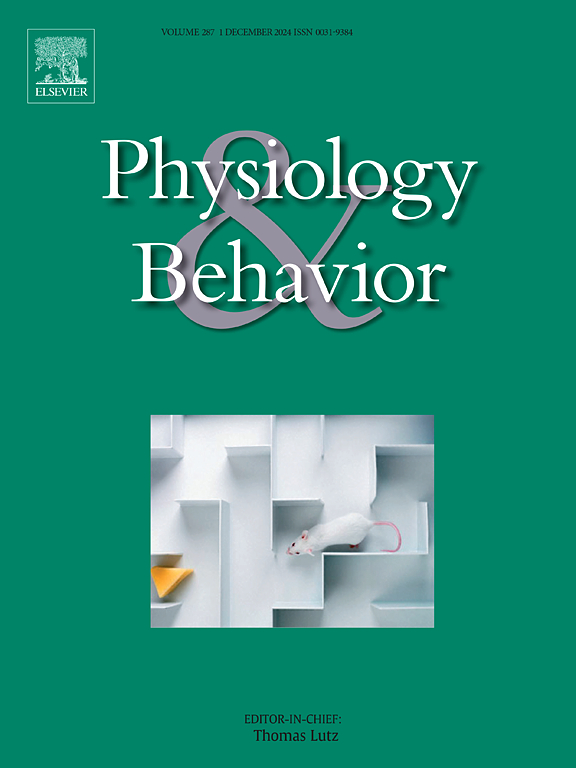Prenatal exposure to Bisphenol A sex-specifically disrupts prepulse inhibition and decreases parvalbumin-positive neurons in the prefrontal cortex of adult rats
IF 2.5
3区 医学
Q2 BEHAVIORAL SCIENCES
引用次数: 0
Abstract
Early-life exposure to bisphenol A (BPA) has adverse effects on neuronal development and behavioral performance; however, many aspects of its effects remain unknown. Here, we aimed to investigate whether prenatal exposure to BPA can induce psychotic-like behaviors and impair certain schizophrenia-related GABAergic markers, including GAD67, NRG1, ERbB4, and parvalbumin (PV), in the prefrontal cortex (PFC) of adult offspring rats. Pregnant Sprague-Dawley rats were orally administered BPA (0.25 and 2.5 mg/kg/day), ethinyl estradiol as a reference estrogen, or a vehicle during the pregnancy period. On postnatal days (PNDs) 62–63, male and female offspring were tested for prepulse inhibition (PPI) and locomotor activity, followed by tissue collection on PND 64. Both doses of BPA significantly decreased PPI in female offspring compared to the control group, while no significant changes were observed in male offspring. Moreover, in female offspring, a marked reduction in the density of PV-positive neurons in the PFC was observed in both BPA groups compared to the control group. In the locomotor activity test, neither sex showed significant changes. Meanwhile, the PFC expression of GAD67, NRG1, and ERbB4 genes did not show significant alterations in either male or female rats. Overall, this study demonstrates that prenatal BPA exposure disrupts PPI and decreases PV-positive neurons in the PFC of adult female rats. In other words, early neurodevelopment can be sex-specifically impaired by BPA, which may consequently increase susceptibility to schizophrenia in adulthood. Therefore, the detrimental effects of BPA on embryonic and fetal brain development should be considered in health policies related to pregnancy.

产前暴露于双酚A性别特异性破坏脉冲前抑制和减少小白蛋白阳性神经元在成年大鼠的前额皮质
生命早期暴露于双酚A (BPA)对神经元发育和行为表现有不利影响;然而,其影响的许多方面仍然未知。在此,我们旨在研究产前暴露于BPA是否会诱发精神类行为,并损害成年后代大鼠前额皮质(PFC)中与精神分裂症相关的gaba能标志物,包括GAD67、NRG1、ERbB4和小白蛋白(PV)。妊娠期给妊娠大鼠口服BPA(0.25和2.5 mg/kg/天)、乙炔雌二醇(作为参考雌激素)或载药。在产后(PND) 62-63天,雄性和雌性后代进行脉冲前抑制(PPI)和运动活动测试,随后在PND 64采集组织。与对照组相比,两种剂量的双酚a均显著降低了雌性后代的PPI,而雄性后代没有明显变化。此外,在雌性后代中,与对照组相比,在BPA组中观察到PFC中pv阳性神经元的密度显着降低。在运动活动测试中,男女均无明显变化。同时,GAD67、NRG1和ERbB4基因在雄性和雌性大鼠PFC中的表达均未出现显著变化。总的来说,本研究表明,产前BPA暴露会破坏成年雌性大鼠PFC中的PPI并减少pv阳性神经元。换句话说,早期的神经发育可能会受到BPA的性别特异性损害,这可能会增加成年后患精神分裂症的易感性。因此,BPA对胚胎和胎儿大脑发育的有害影响应在与妊娠有关的卫生政策中予以考虑。
本文章由计算机程序翻译,如有差异,请以英文原文为准。
求助全文
约1分钟内获得全文
求助全文
来源期刊

Physiology & Behavior
医学-行为科学
CiteScore
5.70
自引率
3.40%
发文量
274
审稿时长
47 days
期刊介绍:
Physiology & Behavior is aimed at the causal physiological mechanisms of behavior and its modulation by environmental factors. The journal invites original reports in the broad area of behavioral and cognitive neuroscience, in which at least one variable is physiological and the primary emphasis and theoretical context are behavioral. The range of subjects includes behavioral neuroendocrinology, psychoneuroimmunology, learning and memory, ingestion, social behavior, and studies related to the mechanisms of psychopathology. Contemporary reviews and theoretical articles are welcomed and the Editors invite such proposals from interested authors.
 求助内容:
求助内容: 应助结果提醒方式:
应助结果提醒方式:


